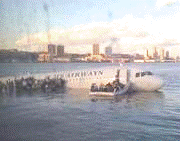Bird Strike Committee Proceedings

Bird Strike Committee-USA/Canada Joint Annual Meeting: 10th (2008)
Date of this Version
8-2008
Document Type
Article
Abstract
Chronologically bird strike prevention has gone through a number of phases. In the beginning of aviation bird strikes were relatively rare and considered unavoidable. With the introduction of faster jet engines, the problem became more prominent and birds were scared away from the runway environment. It was soon recognized that these re-active, corrective measures had to be accompanied by a pro-active, preventive approach in the form of habitat management. Nowadays, bird strike prevention is part of legislation, auditing and Safety Management Systems. It is however, still characterized to a great extend by measures that counter the problem instead of containing it. The RNLAF is actively searching for ways to put more emphasis on containing the problem rather than only counter it by a one dimensional zero tolerance approach. Therefore, parallel to the meteo status, RNLAF airbases are assigned a dynamic bird status. These are based on actual observations by well trained bird controllers and determine both the level and intensity of bird control as well as the operational use of the airbase. The method used is discussed, some results are presented and gaps in knowledge are identified. A second instrument for containing the problem is the use of dedicated bird radars on airfields. These should be able to project the 3D flight path of birds in relation to that of starting aircraft. The developments which take place within the FlySafe project as part of the Integrated Application Promotion Program of the European Space Agency are discussed. Both bird control units and air traffic control are parties that could turn this information into a safer runway environment. The different user interfaces needed are discussed, as well as the implications for day to day operations.


Comments
Abstract of paper presented at Bird Strike Committee USA/Canada Meeting, Lake Mary and Sanford, Florida, August 18–21, 2008.